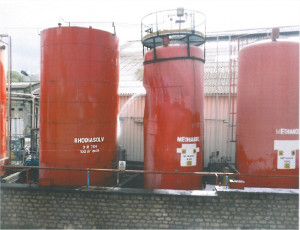In a chemical plant, an operator performs a watch at the restarting of an esterification process when he finds a leak on a methanol storage tank (CH4O, flammable liquid) supplying the process. The top of the tank is crushed and methanol flows freely through a tear into the retention basin of a neighboring tank, a leakage is also found from the breathing pipe of the tank in the same basin. The Internal emergency plan is triggered, the plant’s firefighters baste the leak with water and cover the basin with foam to prevent the methanol ignition. The plant’s storm waters network is isolated as a precaution. The leak stops when the reservoir’s level falls below the height of the tear. Ten tons of methanol are collected in the retention basin. The mixture of water and methanol stored in the basin is then pumped by a specialized company.
Two tanks of 50 m³ of methanol feed the continuous esterification process of the neighboring workshop. In normal operation, the tanks have their bottom valve open and are connected through a pipe feeding the reactor with a pump. A discharge of excess methanol is pumped back to Tank 1 because the pump flow is ten times the normal flow necessary for the process. When the workshop is stopped, the pump process is stopped and the two tanks bottom valves are closed manually, by following a check list. In addition, each tank is supplied with nitrogen through a pipe (breathing pipe) to inert their gaseous atmosphere a the top. The breathing pipe also keeps the tank pressure positive while the tank is emptied, to prevent the tank crushing through internal depressurization. Three years before the accident, a second pump and pipe were installed on the same tanks to supply methanol to the organic waste water treatment plant during the shutdown period of the process (to keep the carbon-degrading bacteria alive). The use of this pipe is rare and is not subject to check list.
On the day of the accident, the esterification process must be restarted after four days off during which the two tanks were refilled with methanol. Shortly before the start, an operator transfer methanol to the waste water treatment plant given the insufficient level of carbon in the waste water. The operator opens the bottom manual valve on Tank 2 as Tank 1 ‘s valve is difficult to access. He stops the pump feeding the treatment plant, but leaves Tank 2 ‘s valve opened. Soon after, another operator in charge of the process restarts the esterification process and infers that Tank 2 ‘s valve is open too (this valve’s position is difficult to check visually). He starts the process pump without verifying the process checklist. Tank 2 is being emptied but remains with internal positive pressure as it is fed with nitrogen by the breathing pipe. Tank 1 is being filled by the arrival of excess methanol from the process but is not being emptied as its bottom valve is still closed: methanol overflows into the breathing pipe at the top of the tank, which lead to the clogging of this pipe. Nitrogen does not arrive anymore in Tank 2, which ends up crashing as a result of the internal depressurization. Its wall is torn by the folding effect and a tear appears. To stop the leakage, the operator opens the bottom valve of Tank 1, leading to the uncloging of the breathing pipe and reestablishing the connection between the two tanks. The two tanks levels are then trimmed (communicating vessels effect) and the return of nitrogen on top of tank 2 increases the leakage flow.
As a feedback, the operator will decommission one of the tank, review the risk analysis of its methanol storage, clarify the roles of operators, remind them the importance of applying the operating check lists step by step and of reporting to the management any difficulties found in the execution of a check list (eg. a valve difficult to access). A technical feedback is also shared with all sistering plants of the company, recommanding to review the design of this type of storage so as to make the overflow pipe and breathing pipe independent; and to consider that the existence of a breathing pipe on a tank, even without shutting valve, is not a 100% safe device against the risk of internal depressurization of a storage tank.




